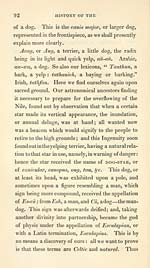Download files
Complete book:
Individual page:
Thumbnail gallery: Grid view | List view

CELTIC LANGUAGE. 93
Mr John Fellows, speaking of the fourth key of the
Egyptian symbolical writing : —
" It was," says he, " the figure of a naan with a dog's head,
wearing oftentimes a pole with one or two serpents twisted
about it. The meaning and intention of the sign shown in the
assembly at the rising of the dog-star, was to advise the
people to run awaj' and give attention to the depths of the
inundation, and to secure their lives and substance. The
names given to this public sign were Anubiis, the barker, the
giver of advices, or Tahaut,* the dog, or yEsculapius the
man-dog."
We have now, the reader will allow, unveiled the
divinity Tau, Teut, Taaut, Tit, or Thoth. He is
neither more nor less than that terrier in our frontis-
piece, sitting upon the pole representing the dog-
star, and, perhaps, originally the deity of fecundity
and generation. His worshippers naturally received
the appellation of Teutones, Titans, 8fc., and his
memory rendered the character T, or Tau, Cabal-
istical, or sacred. We have also arrived at the
primitive idea of the national appellation Cush ;
from Cu, a dog, and Esh, a man : equivalent to
jEs-cU, Scuthai, Cuthites, Cutheans, Kumerians,
worshippers of the man-dog ; they seized upon the
regions of Babylonia and Chaldea, and constituted
the first kingdom, probably, upon earth: they
differed from the then Arabians, Oreitce, Eruthre-
* Tahut is properly the barker, not Anubus.
Mr John Fellows, speaking of the fourth key of the
Egyptian symbolical writing : —
" It was," says he, " the figure of a naan with a dog's head,
wearing oftentimes a pole with one or two serpents twisted
about it. The meaning and intention of the sign shown in the
assembly at the rising of the dog-star, was to advise the
people to run awaj' and give attention to the depths of the
inundation, and to secure their lives and substance. The
names given to this public sign were Anubiis, the barker, the
giver of advices, or Tahaut,* the dog, or yEsculapius the
man-dog."
We have now, the reader will allow, unveiled the
divinity Tau, Teut, Taaut, Tit, or Thoth. He is
neither more nor less than that terrier in our frontis-
piece, sitting upon the pole representing the dog-
star, and, perhaps, originally the deity of fecundity
and generation. His worshippers naturally received
the appellation of Teutones, Titans, 8fc., and his
memory rendered the character T, or Tau, Cabal-
istical, or sacred. We have also arrived at the
primitive idea of the national appellation Cush ;
from Cu, a dog, and Esh, a man : equivalent to
jEs-cU, Scuthai, Cuthites, Cutheans, Kumerians,
worshippers of the man-dog ; they seized upon the
regions of Babylonia and Chaldea, and constituted
the first kingdom, probably, upon earth: they
differed from the then Arabians, Oreitce, Eruthre-
* Tahut is properly the barker, not Anubus.
Set display mode to: Large image | Transcription
Images and transcriptions on this page, including medium image downloads, may be used under the Creative Commons Attribution 4.0 International Licence unless otherwise stated. ![]()
| Early Gaelic Book Collections > Blair Collection > History of the Celtic language > (99) |
|---|
| Permanent URL | https://digital.nls.uk/76179698 |
|---|
| Description | A selection of books from a collection of more than 500 titles, mostly on religious and literary topics. Also includes some material dealing with other Celtic languages and societies. Collection created towards the end of the 19th century by Lady Evelyn Stewart Murray. |
|---|
| Description | Selected items from five 'Special and Named Printed Collections'. Includes books in Gaelic and other Celtic languages, works about the Gaels, their languages, literature, culture and history. |
|---|

